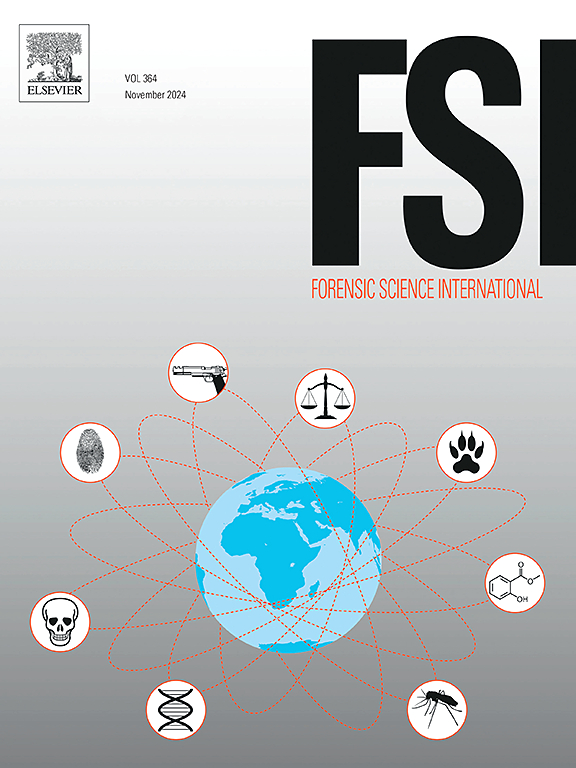A ten-year analysis of drug-facilitated crimes: Prevalence and characteristics at a tertiary hospital victim protection center
IF 2.5
3区 医学
Q1 MEDICINE, LEGAL
引用次数: 0
Abstract
Drug-Facilitated Crimes (DFCs) involve criminal offenses where the victim's intoxicated state plays a central role. The substances used, often central nervous system depressants, are challenging to detect, leading to a high rate of undiagnosed cases. As a result, DFCs remain a form of violence that is weakly characterized. This cross-sectional study analyzed 1104 violence-related cases presented to the Children and Victim Protection Center (CAVPC) at a tertiary hospital. Of these, 12.2 % were suspected to be DFCs between 2014 and 2019, while 38.5 % were suspected to be DFCs between 2020 and 2023 (p < 0.001). This suggests a 544 % increase in the volume of DFC-related cases between the two time periods. Victims were predominantly female (86.4 %) and aged 20–30 years, though a concurrent rise in male victims, from 3.5 % in 2014–2019–15.1 % in 2020–2023 was also observed (p = 0.01). Perpetrators were primarily male (96.2 %), acted alone, and were known to the victim in 51.9 % of the cases. The crimes, which predominantly occurred in private settings between 2014 and 2019, increasingly took place in public spaces between 2020 and 2023 (p = 0.01), where alcohol was present, and peaked on weekends (especially Saturdays) and during late-night and early-morning hours. Most victims exhibited signs of amnesia (91.8 %) and physical injuries (58.4 %). Alarmingly, only 38.5 % of victims sought help within 12 h, significantly reducing the chances of detecting certain substances. Cannabinoids, cocaine, diphenhydramine, paracetamol and lidocaine were the most commonly identified substances in blood and urine. These findings highlight the urgent need for action, including implementing preventive measures, raising awareness, and reducing stigma – an approach that could help address the growing global public health concern of DFCs.
毒品犯罪十年分析:某三级医院受害者保护中心的流行与特点
毒品促进犯罪(dfc)涉及刑事犯罪,受害者的醉酒状态起着核心作用。所使用的物质通常是中枢神经系统抑制剂,很难检测出来,导致未确诊病例的比例很高。因此,发展中国家冲突仍然是一种特征较弱的暴力形式。这项横断面研究分析了向一家三级医院的儿童和受害者保护中心(CAVPC)提交的1104起与暴力有关的案件。其中,2014年至2019年期间,12.2 %被怀疑为dfc,而2020年至2023年期间,38.5 %被怀疑为dfc (p <; 0.001)。这表明在这两个时期之间,与dfc相关的病例数量增加了544 %。受害者主要是女性(86.4 %),年龄在20-30岁之间,尽管男性受害者也同时上升,从2014 - 2019年的3.5 %上升到2020-2023年的15.1 % (p = 0.01)。肇事者主要是男性(96.2 %),单独行动,并且在51.9 %的案件中为受害者所知。这些犯罪在2014年至2019年期间主要发生在私人场所,在2020年至2023年期间越来越多地发生在公共场所(p = 0.01),这些场所存在酒精,并在周末(特别是周六)以及深夜和清晨达到高峰。大多数受害者表现出失忆(91.8% %)和身体损伤(58.4% %)的迹象。令人震惊的是,只有38.5 %的受害者在12 小时内寻求帮助,这大大降低了检测到某些物质的机会。大麻素、可卡因、苯海拉明、扑热息痛和利多卡因是血液和尿液中最常见的物质。这些调查结果突出表明,迫切需要采取行动,包括实施预防措施、提高认识和减少污名化——这一方法可以帮助解决发展中国家日益严重的全球公共卫生问题。
本文章由计算机程序翻译,如有差异,请以英文原文为准。
求助全文
约1分钟内获得全文
求助全文
来源期刊

Forensic science international
医学-医学:法
CiteScore
5.00
自引率
9.10%
发文量
285
审稿时长
49 days
期刊介绍:
Forensic Science International is the flagship journal in the prestigious Forensic Science International family, publishing the most innovative, cutting-edge, and influential contributions across the forensic sciences. Fields include: forensic pathology and histochemistry, chemistry, biochemistry and toxicology, biology, serology, odontology, psychiatry, anthropology, digital forensics, the physical sciences, firearms, and document examination, as well as investigations of value to public health in its broadest sense, and the important marginal area where science and medicine interact with the law.
The journal publishes:
Case Reports
Commentaries
Letters to the Editor
Original Research Papers (Regular Papers)
Rapid Communications
Review Articles
Technical Notes.
 求助内容:
求助内容: 应助结果提醒方式:
应助结果提醒方式:


